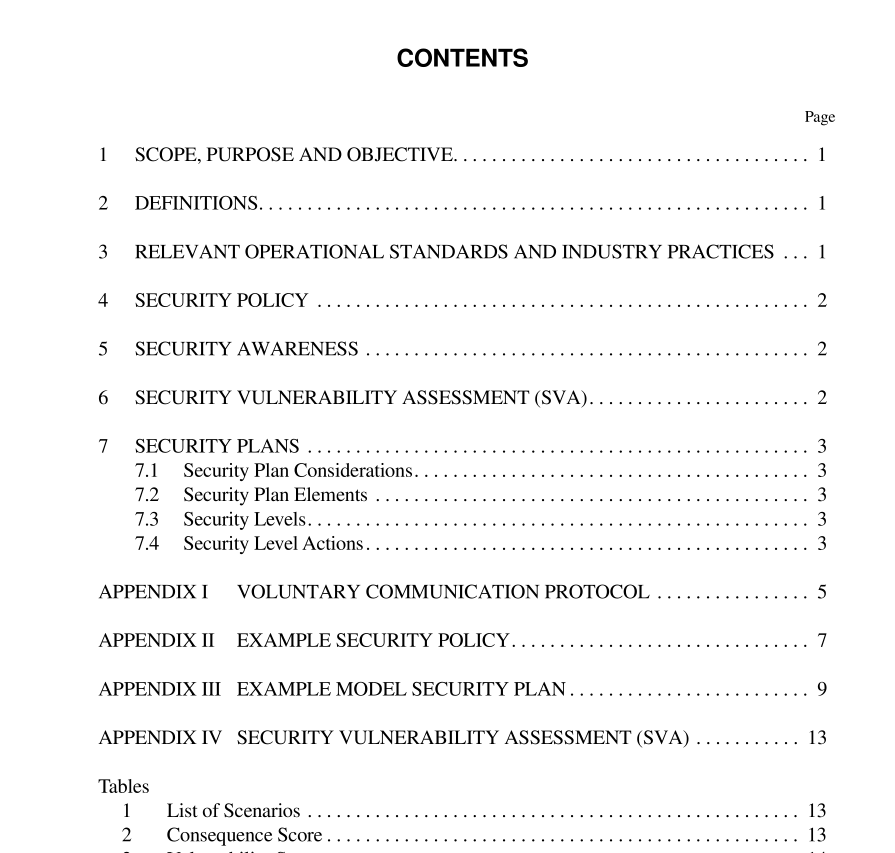API RP 70I pdf download

API RP 70I pdf download.Security for Worldwide Offshore Oil and Natural Gas Operations
1 Scope, Purpose and Objective
This publication is intended to assist the offshore oil and natural gas drilling and producing operators and contractors in assessing security needs during the performance of oil and natural gas operations. The offshore oil and natural gas indus- try uses a wide variety of contractors in drilling, production, and construction activities. Contractors typically are in one of the following categories: drilling, workover, well servicing, construction, electrical, mechanical, transportation, painting, operating, and catering/janitorial.
2 Definitions
2.1 company security officer (CSO): The CSO is responsible for the maintenance of the Security Plan. The CSO shall have access to relevant security information. The CSO shall determine which information, and by what means, it is communicated. The CSO may delegate duties as neces- sary to assure timely completion of responsibilities. The CSO may be assigned other duties and responsibilities unrelated to security. 2.2 contractor: the individual, partnership, firm, or cor- poration that is hired to do a specific job or service, such as a production operator, drilling or well servicing contractor or to provide contract employees to an owner/operator; a contrac- tor is also the individual, partnership, firm, or corporation retained by the owner or operator to perform other work or provide supplies or equipment. The term contractor shall also include subcontractors.2.3 facility: Any artificial island, installation, or other device permanently or temporarily attached to the subsoil or seabed of offshore locations, erected for the purpose of exploring for, developing, or producing oil, natural gas or mineral resources. This definition includes mobile offshore drilling units (MODUs). 2.4 facility owner/operator: The individual, partner- ship, firm, or corporation having control or management of offshore operations. The owner/operator may be a lessee, des- ignated agent of the lessee(s), or holder of operating rights under an operating agreement. 2.5 facility security officer (FSO): The individual that is responsible for security duties as specified by the owner/ operator at one or more facilities, depending on the number or types of facilities a company operates. Where a person acts as the FSO for more than one facility, it should be clearly identi- fied in the facility security plan for which facilities this person is responsible. The FSO may be a collateral duty provided the person is fully capable to perform the duties and responsibili- ties required of the FSO.2.6 point of embarkation: The heliport or dock facility from which personnel and materials are shipped to or received from the offshore facility. Appropriate security mea- sures at these facilities are critical. 2.7 security vulnerability assessment (SVA): A sec- ondary evaluation that examines a facility’s characteristics and operations to identify potential threats or vulnerabilities and existing and prospective security measures and proce- dures designed to protect a facility. 2.8 threshold characteristics/operating condi- tions: Criteria established by relevant governmental agen- cies or the facility owner/operator for screening critical offshore facilities. This is the primary Facility evaluation.
3 Relevant Operational Standards and Industry Practices
API and the oil and gas industry maintain a number of design and operational recommended practices that address aspects of safety and security in offshore oil and natural gas operations. While none of these were developed specifically for security reasons, aspects of them are directly applicable. In many cases, prudent safety procedures would also serve to address appropriate security precautions. These recom- mended practices provide a starting point for developing guidance on security, if needed, at offshore oil and natural gas operating facilities. The following list of recommended practices address oper- ational measures: • Recommended Practice 2A, Planning, Designing, Con- structing Fixed Offshore Platforms . Contains engineer- ing design principles and practices for fixed offshore platforms including assessment of existing platforms, and fire, blast, and accidental overloading. • Recommended Practice 2FPS, Planning, Designing, Constructing Floating Production Systems (FPSOs). This recommended practice provides guidelines for design, fabrication, installation, inspection and opera- tion of floating production systems. • Recommended Practice 2T, Planning, Designing, and Constructing Tension Leg Platforms (TLPs). Summa- rizes available information and guidance for the design, fabrication and installation of a tension leg platform. • Recommended Practice 14B, Design, Installation, Repair and Operation of Subsurface Safety Valve Sys- tems. Provides guidelines for safe operating practices of equipment used to prevent accidental release of hydrocarbons to the environment in the event of unforeseen circumstances.









